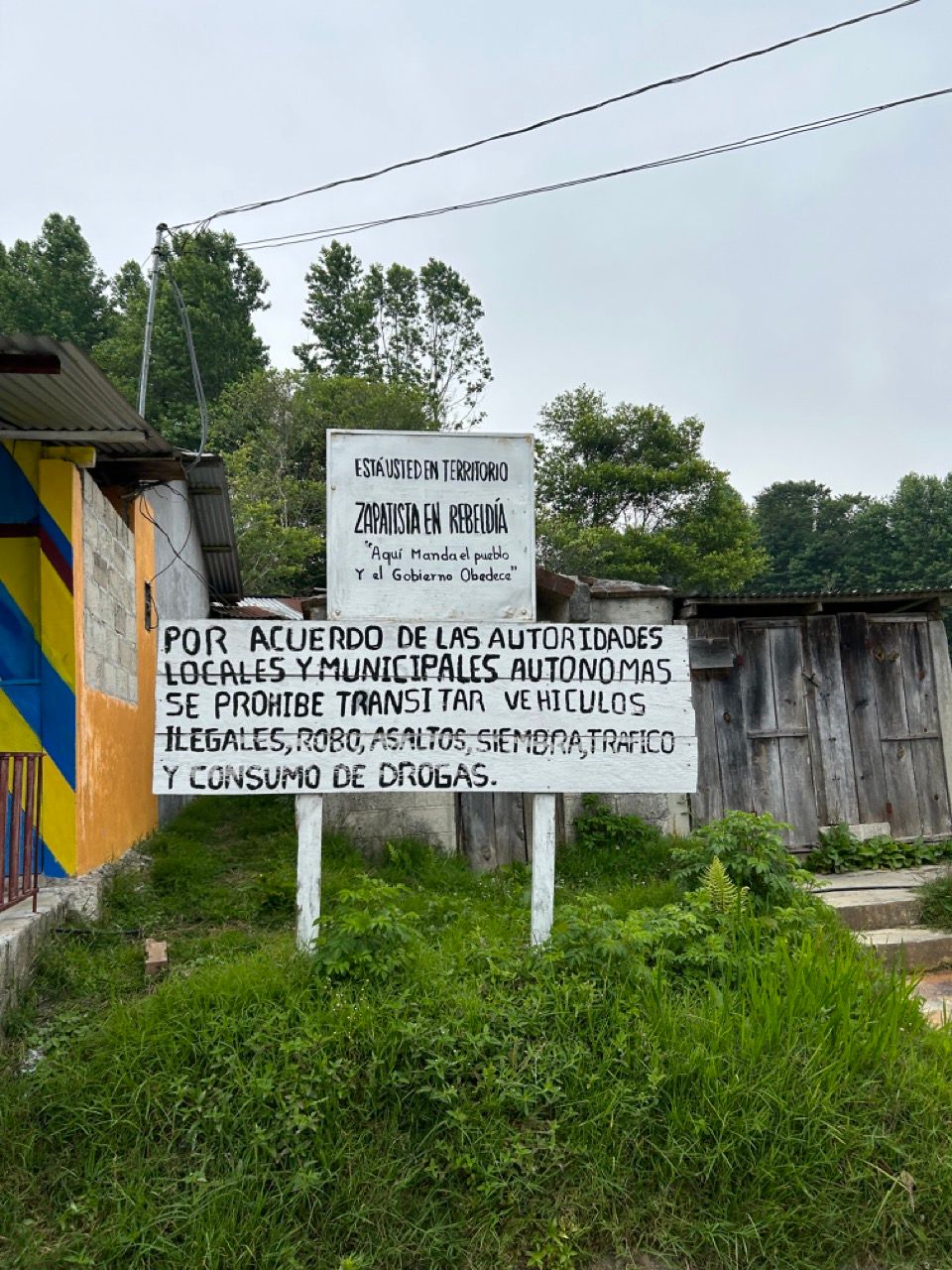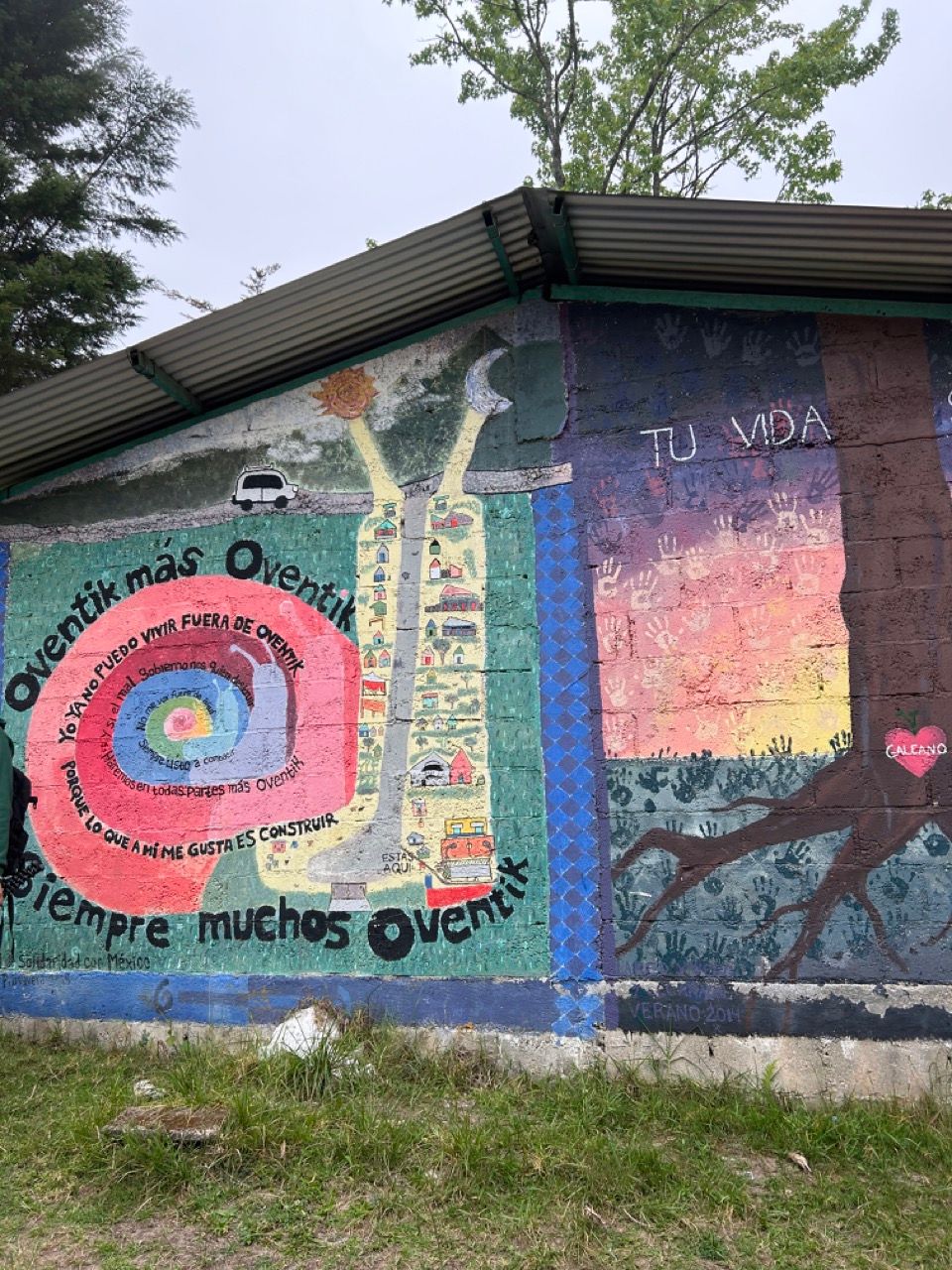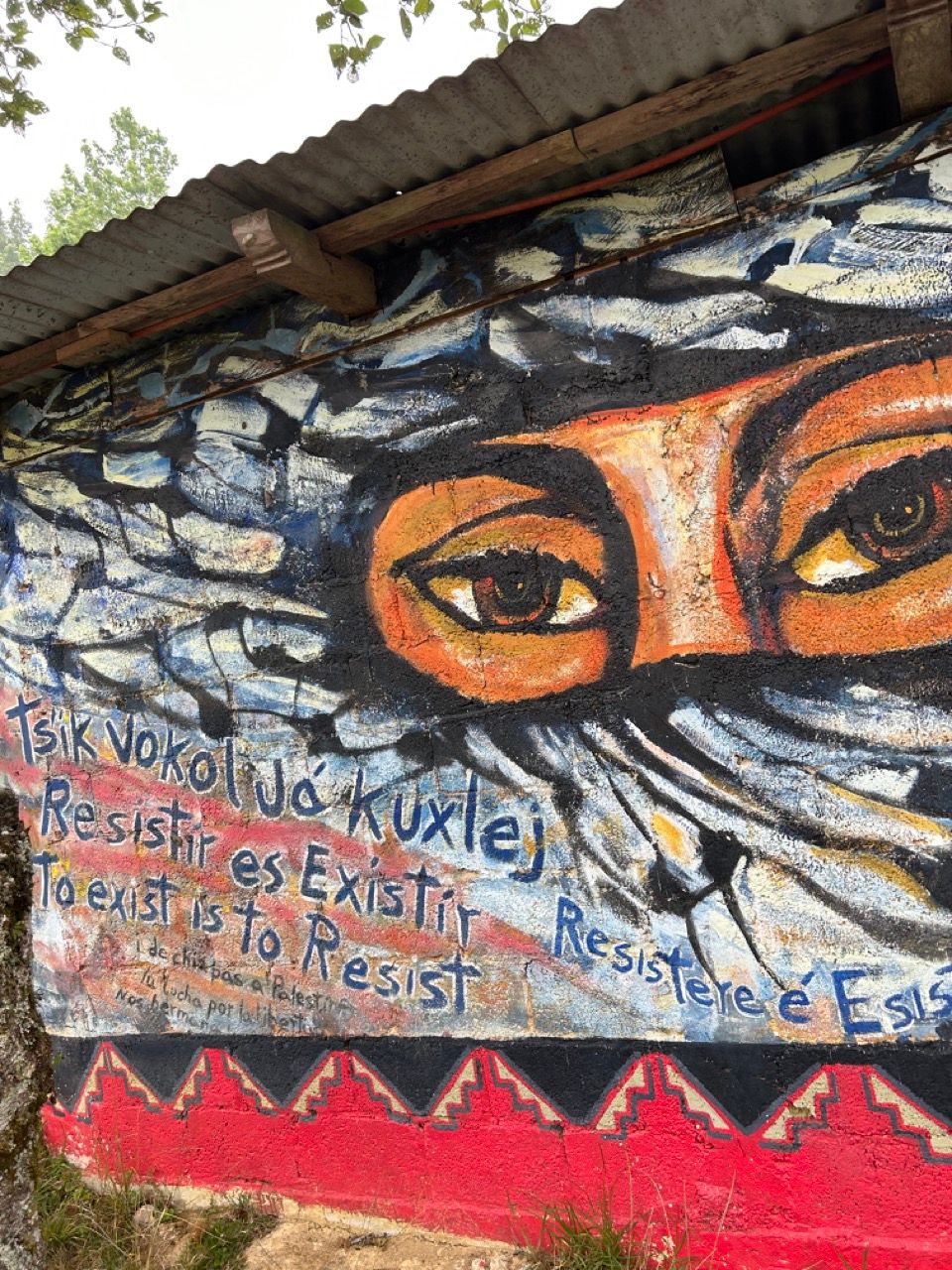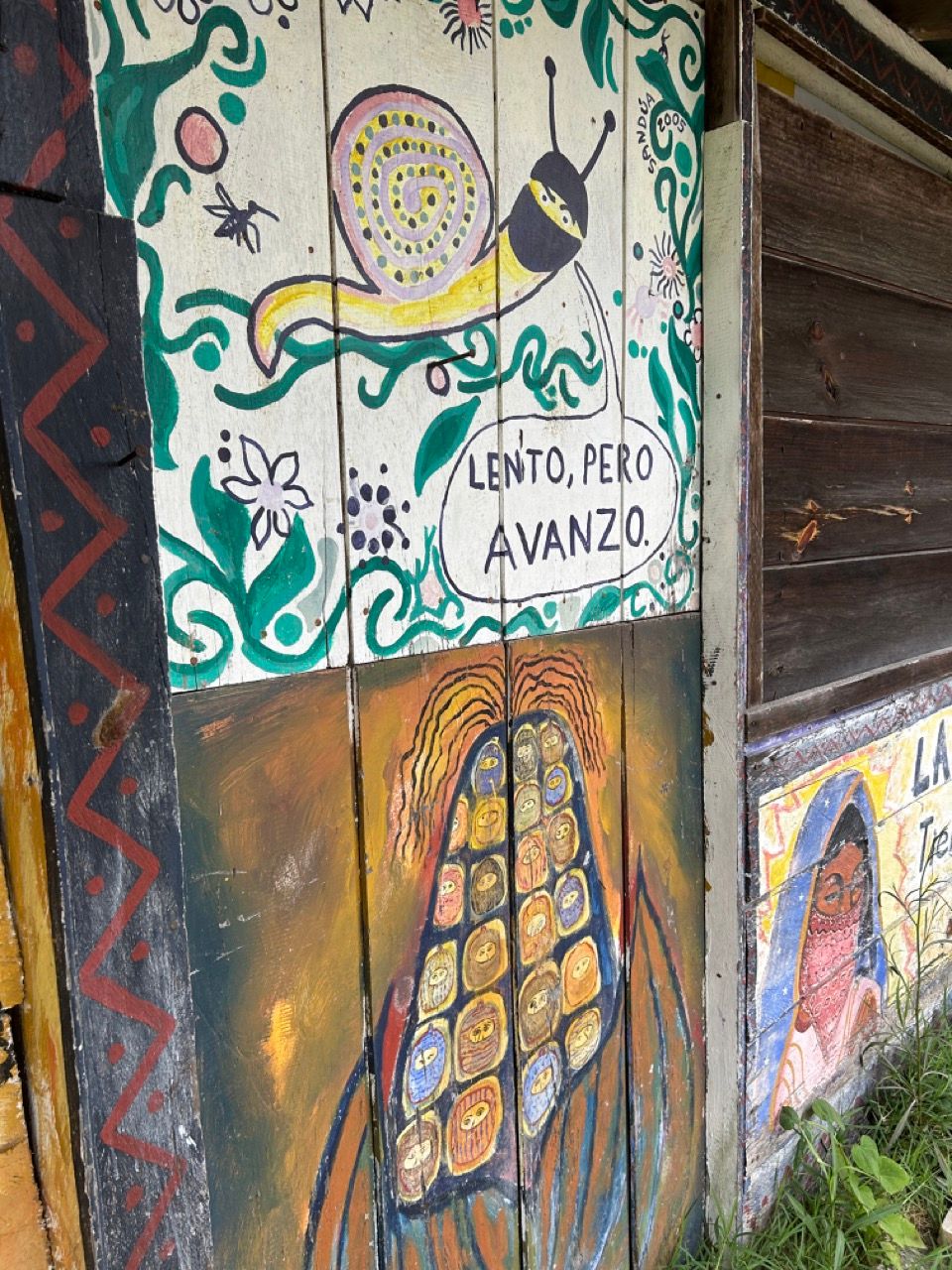the police can't go here
i'm back. not just to this newsletter, but from a life-changing trip.
i spent a week this April on a trip back to San Cristobal de Las Casas to study Spanish more seriously in hopes of better supporting some of my students. i also went with the hope that i might get to visit the local headquarters of the Zapatistas, an autonomous, leftist, anarchist group of revolutionaries i have been studying and admiring for years. on our fourth day in San Cris, i gathered the knowledge, funds, and confidence to make the trip to the autonomous zone. one of my friends on the trip came with me. we left class a little early, grabbed sandwiches, and set out for the mountains.
after a long blur of tight turns, rises, and dips, our taxi driver (who had some of the best teeth jewelry i've ever seen) pulled to the side of the road in front of a black and red metal gate. behind the gate was a downhill road with buildings on each side covered in murals. this was Oventik, the only Zapatista headquarters accessible to the general public.
Oventik is an hour away from San Cristobal, one of 55 autonomous municipalities governed completely by the people with no support or oversight from the Mexican government. some 50,000 families, or nearly 300,000 people live within these municipalities and some say as much as 1/3 of Chiapas is autonomous territory.
a man named Guillermo came to the gate. he asked why we were there. i indicated our desire to learn from the Zapatistas, listing off questions i had practiced in my Spanish class that morning. he handed us a clipboard and we completed registration paperwork. he left to bring the forms to be processed, and an American woman and a Moroccan man pulled up on a motorcycle.
they were eager to talk to me. the feeling was not mutual. it turned out they had met the day before. he had been to Oventik once a few months back. she had never heard of the Zapatistas. by way of summary, he told her "the police can't go here." when a second man with a clipboard arrived, the man from Morocco asked him in Spanish to prove his point. the man from Oventik shook his head to indicate no, the police cannot come here.

i shouldn't look down my nose at them. after all, at one point this fact was what caught my attention about the Zapatistas. they had established a network of communities without police, where federal armies were not welcome. this was enough to hook me, but what i had really wanted to know was what they built in the absence of police.
i have read the declarations put forth by the Zapatistas intermittently since 1994. i find them inspiring not just in their revolutionary messaging, but in their transparency about the mistakes that have been made in building the new world that their slogan, "otro mundo es posible," declares can be built. last time i was in Chiapas, i studied Mayan ways of being, healing, and organizing society, but this didn't tell me what was happening here, today for the people in autonomous zones. i came full of questions like:
how did a community govern themselves, provide for themselves, care for themselves in the present context of global capitalism and corporate capture of national governments and natural resources? how did a group of indigenous people reject colonial and neoliberal structures and rule and live to tell about it? was it possible that they were finding ways to thrive in their absence?
luckily for me, because the man from Morocco had visited before, he and the American woman were let in before i was. the man who had nodded to the police question apologized that i would need to wait a little longer. i was relieved that the American woman wouldn't be next to me recording herself talking the entire time. Guillermo returned. he apologized that because it was spring break, there was no one there that day who could answer my questions. he offered me a tour of the caracol as a consolation.
each regional organization of the Zapatistas is called a caracol (the word for snail in spanish). the caracol is the hub of the community. it is where people come for community support within autonomous Zapatista communities, rejecting government services. Caracol Oventik has schools, a community clinic and ambulances, a building for the cultivation and distribution of natural medicine and healthy food, artisanal shops full of handcrafts made by a collective of women artists, a house of "good government," two auditoriums for community gatherings, two basketball courts, an office space for "women for dignity," a church, and more. the walls of almost every building in the caracol are covered in murals of revolutionary sentiment portraying Zapatista values and solidarity with indigenous groups from Canada to Palaestine to Mozambique.



i asked Guillermo what he would want me to teach my students about the Zapatistas, if there was anything in particular. he told me that was not for him to decide.
"diles todo y ellos pueden decidir lo que es importante"
for last two weeks, a national and international group supporting the National Indigenous Congress of Mexico and the Zapatistas has been making its way in a caravan through Mexico to protest a railroad mega-projects, the modernization of the Isthmus of Tehuantepec Railroad (FIT, Ferrocarril del Istmo de Tehuantepec). check out the article below for more information on this project of global capitalism and the ways that it will degrade the lives of indigenous people in the region.

in the last week, at least six caravan member and supporters have been detained after a violent show of force from the Mexican National Guard, the Mexican Navy, and the Oaxaca state police.
to follow and support the caravan and the Zapatistas, link with Sexta Grietas del Norte.
in attempting to distill my thoughts about all of this, i have been supported by the ideas shared by Dissenters organizers facilitated by Dean Spade at an event called, "it's all policing, it's all war." you can watch it below:
i am not rushing myself into having any crystalized realizations to share with you; my study of abolition and, hopefully, my relationship with the Zapatistas is ongoing. instead, i'm grateful to have this space to share all the things i've been thinking about with an audience of people wondering about what we can become.
thank you for your support.
as always, i hope it was useful.
if it was and you've got five bucks a month to spare, click here.
with hope,
katie wills evans

